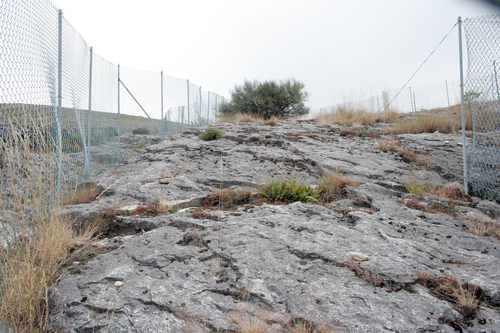|
Pedras Parideiras [Arouca Geoparque]
|
| Este tipo de granito é único em Portugal e raro no mundo. O granito da Castanheira é considerado uma "anomalia" do granito da Serra da Freita. Em 1993, três geólogos do Reino Unido publicaram um estudo sobre a génese deste granito. Concluíram que a sua formação terá ocorrido devido à separação, na fase final da cristalização magmática do granito da Serra da Freita, de um fluido cloretado rico em voláteis. No processo ter-se-á gerado um gradiente químico na interface magma / bolha de voláteis, que favoreceu a complexação e a mobilização de ferro do magma residual. A bolha, menos densa que o magma, terá ascendido, ficando como que a flutuar no tecto desta porção da câmara magmática. |
 |
|
A cache:
Para fazer o log desta cache, terão de ver este fenómeno com os vossos próprios olhos e enviar-me por e-mail os seguintes dados:
1 - o número de degraus do passadiços de madeira da área das Pedras Parideiras.
2 - uma estimativa da área (em m2) correspondente à que está dentro do passadiço.
3 - uma explicação à seguinte pergunta: Porque é que numa visita a este local nunca vão ver uma pedra a ser "parida".
Ao logar, uma foto é bem-vinda.
|
Atenção, NÃO retirem nenhuma pedra do local.
Não destrua as pedras, em vez disso tirem fotos. |
 |
Esquema estrutural do granito da Serra da Freita e do granito nodular da Castanheira (adaptado do estudo de Reavy et al., 1993).
Schedule of structural granite Serra da Freita and the granite of nodular Castanheira (adapted from the study of Reavy et al., 1993). |
The "pedras parideiras" (rocks giving birth) are a natural phenomenon unique in Portugal and extremely rare in the whole world. So far it's only known in this region and in other region in Ucrania.
The "pedras parideiras" are granite rocks with numerous golden nodules that, with a specific temperature, pop out from its rock "mother" and fall on the surrounding floor.
Near the village of Castanheira (parish of Albergaria - 146 inhabitants) in the southern border of the county, is what is the most famous geological phenomenon of Arouca, "pedras parideiras" (rocks giving birth). This is a small (1000 x 600 m) outcrop of granite with abundant biconvex discoid nodules and biotite, which are released from the rock-mother for termoclastia, accumulating in the soil. The nodules, from 1 to 12 cm in diameter, have the same mineralogical composition of granite, although it made externally only by biotite, they have a core of quartz and potassium feldspar. This type of granite is unique in Portugal and rare in the world. The granite of Castanheira is considered an "anomaly" of the granite Serra da Freitas. In 1993, three geologists from the United Kingdom published a study on the genesis of granite. They concluded that the formation happened due to separation, in late magmatic crystallization of the granite Serra da Freitas, from a fluid rich in chloride volatile. In the process was generated a chemical gradient at the interface magma / bubble of volatile, which favored the complexation of iron and mobilization of residual magma. The bubble, less dense than the magma, has risen, leaving “floating” in the ceiling of this portion of the magmatic chamber.
|
The Cache:
To log this cache, you’ll have to see this unique phenomenon for your own eyes and send me these informations:
1 - How many stairs is there in the pathway of wood around the main area.
2 - Calculate the area (in m2) of the Pedras Parideiras area inside the pathway of wood.
3 - Explain me why you'll never be able to see a rock giving birth to another one when you'll visit the earthcache.
You will receive the authorization to log this earthcache.
On your log, a photo is welcome. |
| CAUTION: DO NOT grab or destroy any stone, take pictures instead. |
| Informações retiradas de / Informations from: http://geologia.aroucanet.com/ |
 |
 |